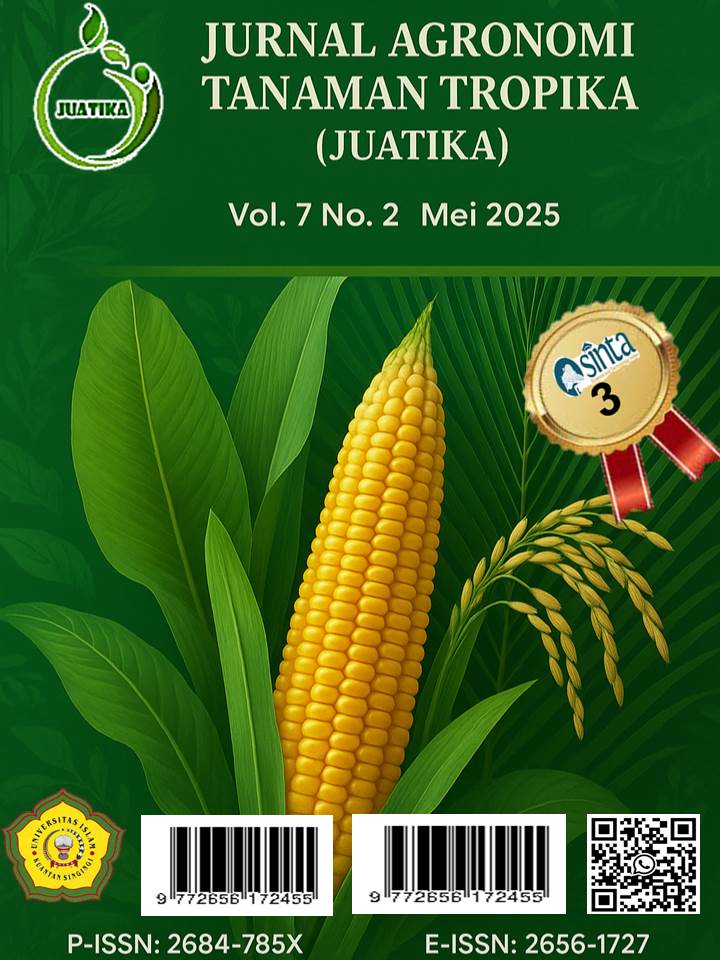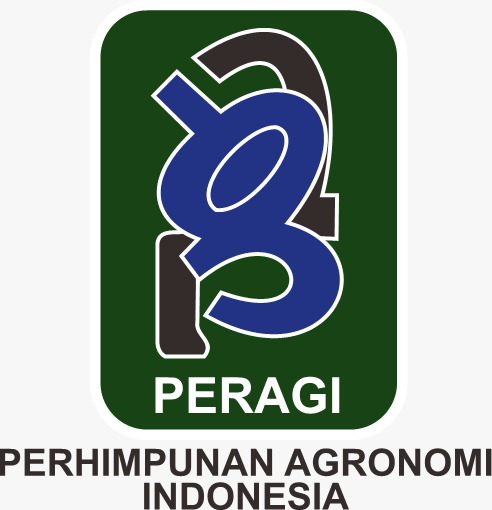Comparison of the Success of Guava Stem Cuttings (Psidium guajava) Using the Chemical Liquinox Start (Vitamin B1), Root Up, and Natural Ingredients of Red Onion (Allium cepa L)
Abstract
Guava (Psidium guajava L.) is a tropical plant that holds significant popularity and economic value in Indonesia. Despite its benefits, many Indonesians still face challenges in successfully cultivating guava seeds. Traditionally, guavas are propagated from seeds, which often results in lower-quality fruit. Seed-grown trees may take longer to bear fruit, and the fruit produced may not resemble that of the parent plant. This study aims to evaluate the success rate of guava propagation using stem cuttings treated with two different chemicals—Root Up and Liquinox Start—as well as a natural alternative, shallot extract. The cuttings were treated uniformly across all treatments, and the growth parameters observed included the number of shoots, the number of leaves, and the length of the shoots over two months from April 20 to June 22, 2025. The results indicated a significant difference between the three treatments. Root Up treatment produced the longest shoot growth on average, while Liquinox Start also showed a relatively high rate of shoot development. Shallot extract, a natural alternative, also yielded promising results, offering an environmentally friendly and easily accessible option for guava propagation. While chemical treatments, such as Root Up, led to optimal results in terms of shoot, leaf, and shoot length development, the use of shallots demonstrates that natural ingredients can also provide a sustainable and effective approach to guava propagation. Based on the findings, Root Up is recommended for accelerating guava plant growth, but shallot extract presents a viable, eco-friendly alternative.
Downloads
References
Agustina, R. (2018). Efektifitas ekstrak daun jambu biji (Psidium guajava L.) terhadap bakteri Aeromonas hydrophila secara in vitro. Universitas Islam Negeri Raden Intan Lampung.
Debitama, A. M. N. H., Mawarni, I. A., & Hasanah, U. (2022). Pengaruh hormon auksin sebagai zat pengatur tumbuh pada beberapa jenis tumbuhan Monocotyledoneae dan Dicotyledoneae. Biodidaktika: Jurnal Biologi dan Pembelajarannya, 17(1).
Fatana, D., Suharli, L., & Sandra, E. (2024). Pembuatan media MS (Murashige and Skoog) dengan tambahan konsentrasi ZPT secara in vitro. Jurnal Satwa Tumbuh Indonesia, 1(1), 9–14. http://www.jurnal.uts.ac.id/index.php/jsti/article/view/3827
Febriani, F., Linda, R., & Lovadi, I. (2015). Pengaruh komposisi media tanam terhadap pertumbuhan stek batang kantong semar (Nepenthes gracilis Korth.). Protobiont, 4(2), 63–68.
Flores, G., Wu, S., Negrin, A., & Kennelly, E. J. (2015). Chemical composition and antioxidant activity of seven cultivars of guava (Psidium guajava) fruits. Food Chemistry, 170, 327–335.
Marpaung, A. E., & Hutabarat, R. C. (2015). Respons jenis perangsang tumbuh berbahan alami dan asal setek batang terhadap pertumbuhan bibit tin (Ficus carica L.). Jurnal Hortikultura, 25(1), 37–43.
Masli, M., Biantary, M. P., & Emawati, H. (2019). Pengaruh zat pengatur tumbuh auksin IAA dan ekstrak bawang merah terhadap perbanyakan stek meranti sabut (Shorea parvifolia Dyer.). Agrifor, 28(1), 167–178.
Monica, Y., Meiriani, & Barus, A. (2017). Pertumbuhan berbagai umur bahan tanam bud set tebu (Saccharum officinarum L.) dengan konsentrasi NAA yang berbeda. Jurnal Agroekoteknologi FP USU, 5(2), 297–306.
Muslimawati, N., Suketi, K., & Susila, A. D. (2015). Pertumbuhan setek batang pohpohan (Pilea trinervia) pada umur tanaman, bagian batang, dan media tanam yang berbeda. Jurnal Hortikultura Indonesia, 6(2), 91–98.
Pakpahan, E. T. (2015). Kajian teknik mencangkok perbanyakan jambu kristal (Psidium guajava). Agrica Ekstensia, 9(2), 27–30.
Rahayu, N. I., Dini, F., Kusmiyati, F., & Putra, F. P. (2023). Effect of planting material and B1 vitamin during acclimatization on the growth of potato (Solanum tuberosum cv. Granola). IOP Conference Series: Earth and Environmental Science, 1246(1).
Setyowati, M., Sarwanidas, T., & Rizawati. (2015). Pertumbuhan jahe merah (Zingiber officinale var. rubrum) pada beberapa konsentrasi dan lama perendaman dalam ZPT atonik. Jurnal Agrotek Rahmawati, 1(1), 67–68.
Susiloadi, A. (2008). Petunjuk teknis teknologi pembibitan jambu biji.
Ulfa, R., & Isda, M. N. (2020). Induksi akar jeruk siam (Citrus nobilis) asal Kampar dari tunas in vitro pada media MS dengan penambahan IBA dan NAA. Jurnal Biologi Universitas Andalas, 8(1).
Wirawan, I. W. A., Dharma, I. P., & Astiningsih, A. A. M. (2018). Pengaruh umur bibit batang bawah dan teknik penyambungan terhadap pertumbuhan bibit jambu biji (Psidium guajava L.). Jurnal Agroekoteknologi Tropika, 7(4), 478–488. https://ojs.unud.ac.id/index.php/jat
Copyright (c) 2025 Ridwansyah Munthe, Hilwa Walida, Dini Hariyati Adam

This work is licensed under a Creative Commons Attribution 4.0 International License.
Authors who publish with Jurnal Agronomi Tanaman Tropika (JUATIKA) agree to the following terms:
Authors retain copyright and grant the Jurnal Agronomi Tanaman Tropika (JUATIKA) right of first publication with the work simultaneously licensed under a Creative Commons Attribution License (CC BY 4.0) that allows others to share (copy and redistribute the material in any medium or format) and adapt (remix, transform, and build upon the material for any purpose, even commercially) with an acknowledgment of the work's authorship and initial publication in Jurnal Agronomi Tanaman Tropika (JUATIKA).
Authors are able to enter into separate, additional contractual arrangements for the non-exclusive distribution of the journal's published version of the work (e.g., post it to an institutional repository or publish it in a book), with an acknowledgment of its initial publication in Jurnal Agronomi Tanaman Tropika (JUATIKA). Authors are permitted and encouraged to post their work online (e.g., in institutional repositories or on their website) prior to and during the submission process, as it can lead to productive exchanges, as well as earlier and greater citation of published work.







 More Information
More Information



